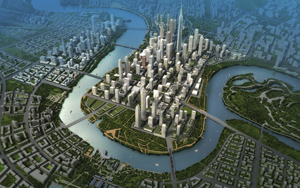
I. Low-Carbon Planning
The Yujiapu Financial Area has embraced low-carbon from the outset. After careful study of city positioning, industrial layout, traffic planning, land development and energy utilization, the Tianjin Municipal Government has formulated Guidelines for Sustainable Development Design of Yujiapu Financial Area and Guidelines for Design of Low-Carbon City. These guidelines are in line with the Chinese government’s stated commitment to energy and emission reductions.
II. Low-Carbon Energy
Using the result of in-depth studies, long-term plans for the Yujiapu Financial Area optimize regional energy supply and utilization methods. While the Regional Energy Center stands to make intensive use of energy and land, the comprehensive energy supply transformation plan – focused on natural gas with graded energy utilization – hopes to provide low-carbon energy for the Yujiapu Financial Area (and perhaps a larger area). By actively exploring various advanced low-carbon energy ideas and technologies, Yujiapu Financial Area will strive to lead in the field of low carbon as the first low-carbon model town in the world.
Ⅲ. Low-Carbon Traffic
The Yujiapu Financial Area’s transportation system is based largely on walking and public transit. With the Beijing-Tianjin Inter-City Express Railway extending to Yujiapu, the Financial Area has realized the integration of inter-city express railway, city subway and city bus systems, enhancing the urban agglomeration effect of Beijing and Tianjin. At the same time, five subway-routes (three transversal and two longitudinal) and a green bus system are planned within the city. With four subway transfer stations located in Yujiapu, it has realized the highest level of public transportation accessibility. Tunnels, pedestrian streets, and bicycle lanes in Yujiapu together enable passengers to travel without having to constantly transfer, making low-carbon traffic and green travel in Yujiapu Financial Area convenient and enjoyable.
Ⅳ. Low-Carbon Finance
Yujiapu Financial Area actively encourages carbon trading institutions to settle there in an attempt to turn itself into a low-carbon economic and finance cluster. Through joint investment with China Galaxy Securities, Yujiapu Financial Area has organized the first low-carbon investment fund company and low-carbon industry fund to provide a convenient financing platform for low-carbon enterprises. With government support in policy and finance, low-carbon finance in Yujiapu should make a strong impact.
What are CO2 emissions reduction target and date to achieve this?
Reduce CO2 emission by 30% in 2020 and 50% in 2030 compared to a 2010 baseline.